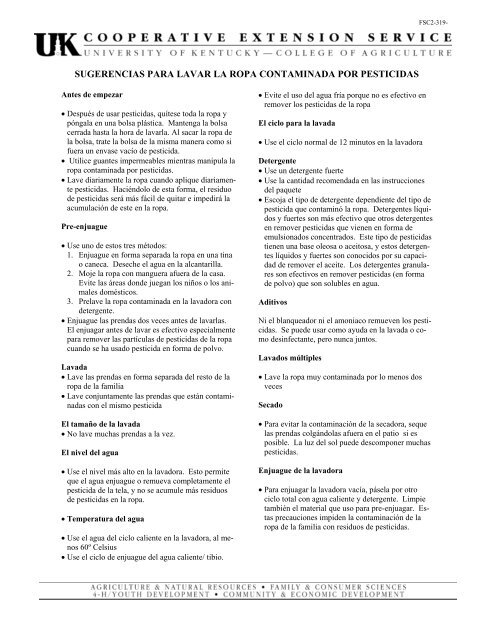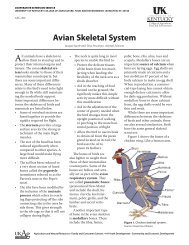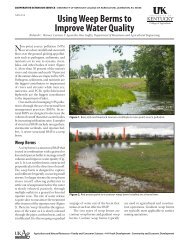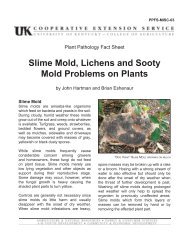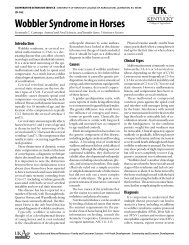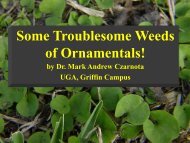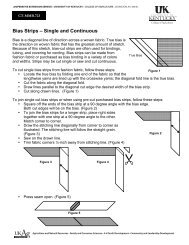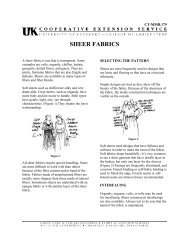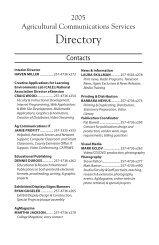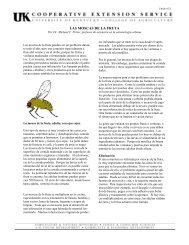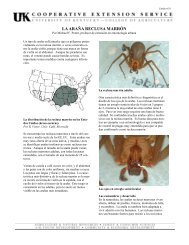sugerencias para lavar la ropa contaminada por pesticidas
sugerencias para lavar la ropa contaminada por pesticidas
sugerencias para lavar la ropa contaminada por pesticidas
You also want an ePaper? Increase the reach of your titles
YUMPU automatically turns print PDFs into web optimized ePapers that Google loves.
SUGERENCIAS PARA LAVAR LA ROPA CONTAMINADA POR PESTICIDAS<br />
Antes de empezar<br />
• Después de usar <strong>pesticidas</strong>, quítese toda <strong>la</strong> <strong>ropa</strong> y<br />
pónga<strong>la</strong> en una bolsa plástica. Mantenga <strong>la</strong> bolsa<br />
cerrada hasta <strong>la</strong> hora de <strong><strong>la</strong>var</strong><strong>la</strong>. Al sacar <strong>la</strong> <strong>ropa</strong> de<br />
<strong>la</strong> bolsa, trate <strong>la</strong> bolsa de <strong>la</strong> misma manera como si<br />
fuera un envase vacío de pesticida.<br />
• Utilice guantes impermeables mientras manipu<strong>la</strong> <strong>la</strong><br />
<strong>ropa</strong> <strong>contaminada</strong> <strong>por</strong> <strong>pesticidas</strong>.<br />
• Lave diariamente <strong>la</strong> <strong>ropa</strong> cuando aplique diariamente<br />
<strong>pesticidas</strong>. Haciéndolo de esta forma, el residuo<br />
de <strong>pesticidas</strong> será más fácil de quitar e impedirá <strong>la</strong><br />
acumu<strong>la</strong>ción de este en <strong>la</strong> <strong>ropa</strong>.<br />
Pre-enjuague<br />
• Use uno de estos tres métodos:<br />
1. Enjuague en forma se<strong>para</strong>da <strong>la</strong> <strong>ropa</strong> en una tina<br />
o caneca. Deseche el agua en <strong>la</strong> alcantaril<strong>la</strong>.<br />
2. Moje <strong>la</strong> <strong>ropa</strong> con manguera afuera de <strong>la</strong> casa.<br />
Evite <strong>la</strong>s áreas donde juegan los niños o los animales<br />
domésticos.<br />
3. Pre<strong>la</strong>ve <strong>la</strong> <strong>ropa</strong> <strong>contaminada</strong> en <strong>la</strong> <strong>la</strong>vadora con<br />
detergente.<br />
• Enjuague <strong>la</strong>s prendas dos veces antes de <strong><strong>la</strong>var</strong><strong>la</strong>s.<br />
El enjuagar antes de <strong><strong>la</strong>var</strong> es efectivo especialmente<br />
<strong>para</strong> remover <strong>la</strong>s partícu<strong>la</strong>s de <strong>pesticidas</strong> de <strong>la</strong> <strong>ropa</strong><br />
cuando se ha usado pesticida en forma de polvo.<br />
Lavada<br />
• Lave <strong>la</strong>s prendas en forma se<strong>para</strong>da del resto de <strong>la</strong><br />
<strong>ropa</strong> de <strong>la</strong> familia<br />
• Lave conjuntamente <strong>la</strong>s prendas que están <strong>contaminada</strong>s<br />
con el mismo pesticida<br />
El tamaño de <strong>la</strong> <strong>la</strong>vada<br />
• No <strong>la</strong>ve muchas prendas a <strong>la</strong> vez.<br />
El nivel del agua<br />
• Use el nivel más alto en <strong>la</strong> <strong>la</strong>vadora. Esto permite<br />
que el agua enjuague o remueva completamente el<br />
pesticida de <strong>la</strong> te<strong>la</strong>, y no se acumule más residuos<br />
de <strong>pesticidas</strong> en <strong>la</strong> <strong>ropa</strong>.<br />
• Temperatura del agua<br />
• Use el agua del ciclo caliente en <strong>la</strong> <strong>la</strong>vadora, al menos<br />
60º Celsius<br />
• Use el ciclo de enjuague del agua caliente/ tibio.<br />
• Evite el uso del agua fría <strong>por</strong>que no es efectivo en<br />
remover los <strong>pesticidas</strong> de <strong>la</strong> <strong>ropa</strong><br />
El ciclo <strong>para</strong> <strong>la</strong> <strong>la</strong>vada<br />
• Use el ciclo normal de 12 minutos en <strong>la</strong> <strong>la</strong>vadora<br />
Detergente<br />
• Use un detergente fuerte<br />
• Use <strong>la</strong> cantidad recomendada en <strong>la</strong>s instrucciones<br />
del paquete<br />
• Escoja el tipo de detergente dependiente del tipo de<br />
pesticida que contaminó <strong>la</strong> <strong>ropa</strong>. Detergentes líquidos<br />
y fuertes son más efectivo que otros detergentes<br />
en remover <strong>pesticidas</strong> que vienen en forma de<br />
emulsionados concentrados. Este tipo de <strong>pesticidas</strong><br />
tienen una base oleosa o aceitosa, y estos detergentes<br />
líquidos y fuertes son conocidos <strong>por</strong> su capacidad<br />
de remover el aceite. Los detergentes granu<strong>la</strong>res<br />
son efectivos en remover <strong>pesticidas</strong> (en forma<br />
de polvo) que son solubles en agua.<br />
Aditivos<br />
Ni el b<strong>la</strong>nqueador ni el amoniaco remueven los <strong>pesticidas</strong>.<br />
Se puede usar como ayuda en <strong>la</strong> <strong>la</strong>vada o como<br />
desinfectante, pero nunca juntos.<br />
Lavados múltiples<br />
• Lave <strong>la</strong> <strong>ropa</strong> muy <strong>contaminada</strong> <strong>por</strong> lo menos dos<br />
veces<br />
Secado<br />
• Para evitar <strong>la</strong> contaminación de <strong>la</strong> secadora, seque<br />
<strong>la</strong>s prendas colgándo<strong>la</strong>s afuera en el patio si es<br />
posible. La luz del sol puede descomponer muchas<br />
<strong>pesticidas</strong>.<br />
Enjuague de <strong>la</strong> <strong>la</strong>vadora<br />
• Para enjuagar <strong>la</strong> <strong>la</strong>vadora vacía, páse<strong>la</strong> <strong>por</strong> otro<br />
ciclo total con agua caliente y detergente. Limpie<br />
también el material que uso <strong>para</strong> pre-enjuagar. Estas<br />
precauciones impiden <strong>la</strong> contaminación de <strong>la</strong><br />
<strong>ropa</strong> de <strong>la</strong> familia con residuos de <strong>pesticidas</strong>.<br />
FSC2-319-
Lavado de otros artículos<br />
• Después de uso, limpie bien <strong>por</strong> dentro y <strong>por</strong> afuera<br />
todo lo que sea <strong>la</strong>vable incluyendo botas, guantes,<br />
sombreros, gafas protectoras, y de<strong>la</strong>ntales. Use<br />
agua caliente y detergente.<br />
Otras <strong>sugerencias</strong><br />
Como muchas <strong>pesticidas</strong> varían en <strong>la</strong> composición<br />
física y química, <strong>la</strong>s recomendaciones dadas aquí y<br />
que han sido basadas en investigación en este folleto,<br />
son generalizadas. Para obtener información sobre<br />
<strong>pesticidas</strong> específicos, póngase en contacto con su<br />
oficina de Extensión del condado local.<br />
• Se ha encontrado que <strong>la</strong> aplicación de almidón sobre<br />
<strong>la</strong> superficie de te<strong>la</strong> actúa como trampa de <strong>pesticidas</strong>.<br />
Los estudios de investigación también indican<br />
que el uso de almidón puede optimizar <strong>la</strong> removida<br />
de <strong>pesticidas</strong> cuando <strong>la</strong> <strong>ropa</strong> <strong>contaminada</strong> es<br />
<strong>la</strong>vada.<br />
• Sea conciente de cuándo y cuáles tipos de <strong>la</strong>s <strong>pesticidas</strong><br />
se usan<br />
• Lleve siempre los guantes impermeables <strong>para</strong> evitar<br />
<strong>la</strong> exposición de <strong>la</strong> piel al pesticida mientras manipu<strong>la</strong><br />
<strong>la</strong> <strong>ropa</strong> <strong>contaminada</strong>.<br />
• Queme o entierre <strong>la</strong>s prendas saturadas con pesticida<br />
concentrado o <strong>pesticidas</strong> que son muy tóxicos.<br />
Quítese <strong>la</strong> <strong>ropa</strong> y pónga<strong>la</strong> inmediatamente en una<br />
bolsa plástica. Cierre <strong>la</strong> bolsa herméticamente.<br />
Después de <strong><strong>la</strong>var</strong> <strong>la</strong> <strong>ropa</strong>, deseche <strong>la</strong> bolsa vacía y<br />
los envases vacíos de pesticida.<br />
• Quítese <strong>la</strong> <strong>ropa</strong> <strong>contaminada</strong> en áreas externas o a <strong>la</strong><br />
entrada de <strong>la</strong> edificación. Si ha usado una pesticida<br />
granu<strong>la</strong>r, sacuda <strong>la</strong> <strong>ropa</strong> afuera. Vacíe los bolsillos,<br />
los puños y los dob<strong>la</strong>dillos.<br />
• Mantenga alejada <strong>la</strong> <strong>ropa</strong> <strong>contaminada</strong> del resto de<br />
<strong>la</strong> <strong>ropa</strong> de <strong>la</strong> familia. Investigaciones han mostrado<br />
que el residuo de <strong>pesticidas</strong> puede ser pasado desde<br />
<strong>la</strong>s prendas <strong>contaminada</strong>s hacia otras prendas si se<br />
<strong>la</strong>van y guardan juntas.<br />
• Use siempre <strong>la</strong> misma <strong>ropa</strong> cuando manipu<strong>la</strong> insecticidas.<br />
Mantenga <strong>la</strong> <strong>ropa</strong> <strong>contaminada</strong> alejada del<br />
resto de <strong>la</strong> <strong>ropa</strong>, antes, durante y después de <strong><strong>la</strong>var</strong><strong>la</strong>.<br />
• Quítese <strong>la</strong> <strong>ropa</strong> <strong>contaminada</strong>, incluyendo <strong>la</strong> <strong>ropa</strong><br />
interior, tan pronto como pueda. Dúchese y lávese<br />
el pelo antes de ponerse <strong>ropa</strong> limpia.<br />
Para <strong>la</strong> información sobre cómo escoger <strong>la</strong> <strong>ropa</strong><br />
apropiada <strong>para</strong> llevar cuando deba usar <strong>pesticidas</strong>,<br />
póngase en contacto con su oficina de Extensión del<br />
condado local.<br />
Escrito <strong>por</strong> Linda Heaton, Especialista de extensión<br />
en textiles y calidad de agua.<br />
Traducido <strong>por</strong> Megan Potter y Alvaro Romero


